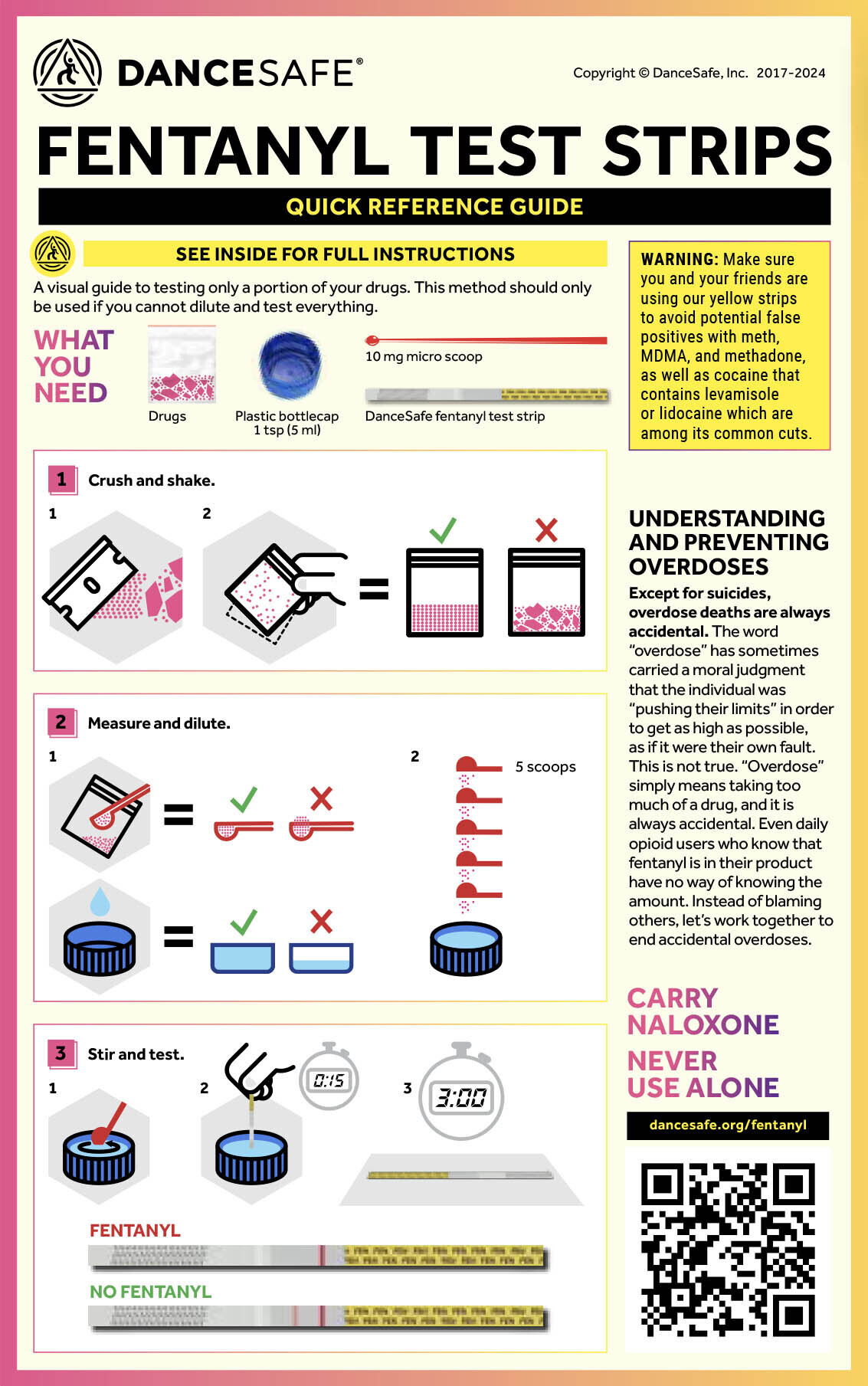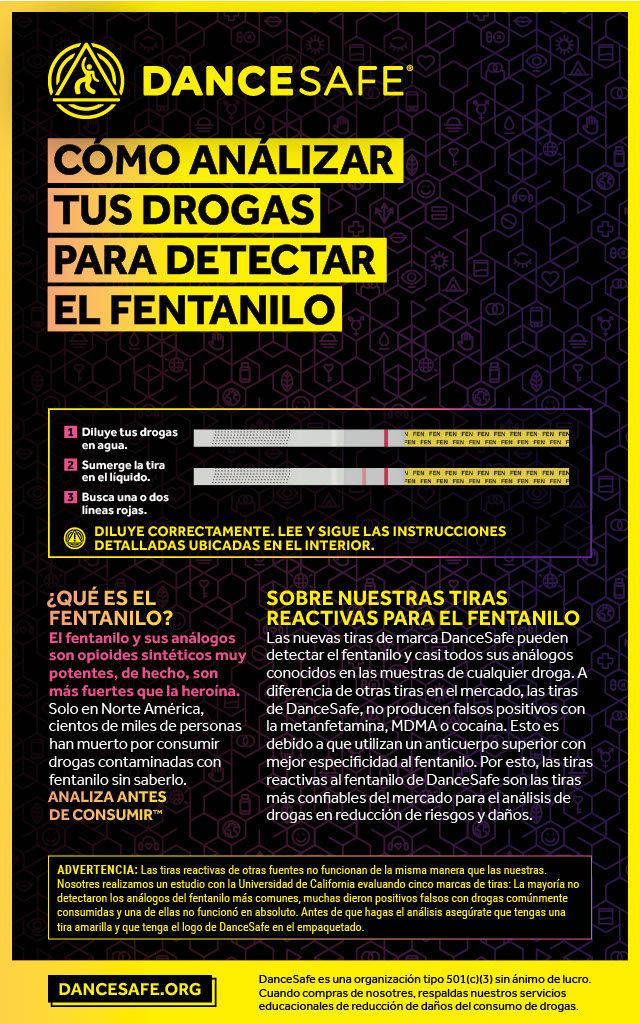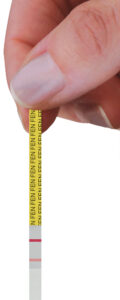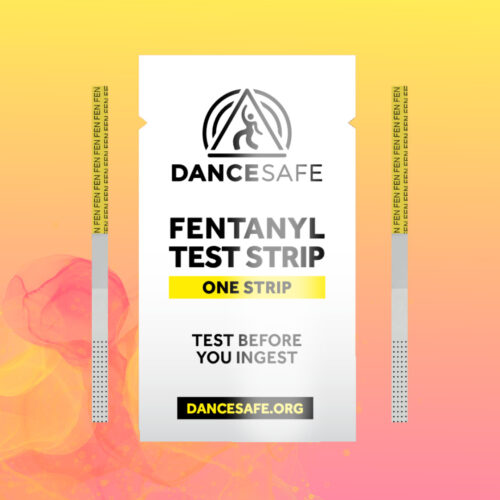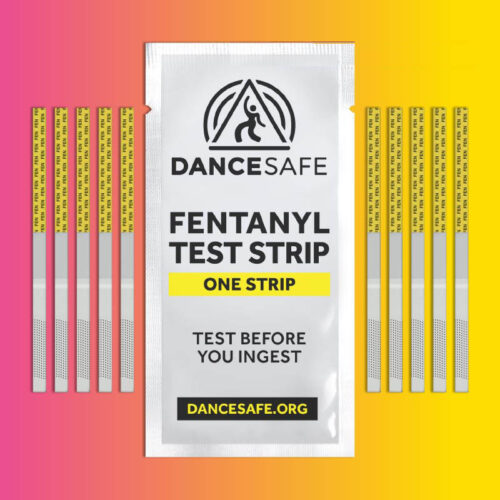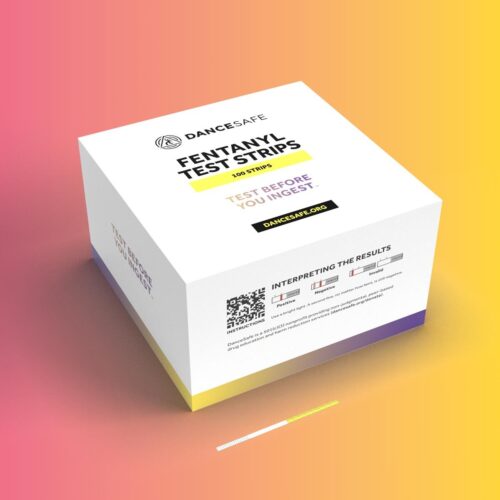Fentanyl
Test everything you intend to consume
Testing everything requires dissolving your entire dose or batch in water.
- For drugs consumed orally, you can dissolve your dose and drink the water after testing. (The strips do not contaminate the water.)
- Dissolving your dose is a good move if you want to test your drugs right before taking them orally. (Ex. Measuring and testing 120 mg of MDMA before consuming it.)
- For drugs like cocaine or meth that people like to insufflate (snort), you can get the powder back by evaporating the water. (Instructions below.)
- Dissolving your entire batch is useful and efficient because you can test all of your doses at once, but you’ll need to take the time to evaporate the water back out before it’s usable.
Testing a portion of your drugs
The best method is to test every bit of the drug you intend to consume, but if you can’t, at least test a good cross section. We recommend a minimum of 50 mg.
- Before doing so, crush any crystals, shards, or rocks into a fine powder.
- Next, mix the powder up as thoroughly as possible by stirring or shaking the baggie.
- This helps distribute any fentanyl that might be clumped up inside, increasing the likelihood that some will be in your sample.
STEP 1: Preparing and diluting your drugs
Whether you are testing everything you intend to consume or a smaller portion of your drugs, you need to dilute the powder in the correct amount of water.
Open the tab and follow the instructions below for each type of drug.

1. Weigh your drugs.
Use a milligram scale to get the weight of the crystals or powder you are going to test. Write it down so you don’t forget. If you don’t have a milligram scale, you can use one of our 10 mg micro scoops.
A level scoop of finely crushed powder (not rounded) is approximately ten milligrams (available here).
2. Place your drugs into a small container.
- If you are testing 50 mg or less, a standard bottle cap from any 20 oz soda bottle works great.
- If you are testing more than 50mg, use a cup or bowl.
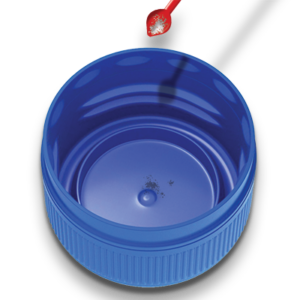
You can use a micro scoop and a bottle cap to test a portion of your drugs. A standard plastic bottle cap holds approximately one teaspoon (5 ml) of water when almost full.
3. Add the right amount of water.
This step is very important.
FOR ALL DRUGS
Add one teaspoon of water (5 ml) for every 50 mg of powder.

NOTE: Use proper measuring spoons, like those for baking.
- 1 US teaspoon is almost exactly 5 ml
- 1 US tablespoon is three teaspoons (15 ml)
- 1 US cup is 48 teaspoons (240 ml)
If you don’t have proper measuring spoons, a standard plastic bottle cap is a bit larger than a teaspoon.
4. Stir the mixture until completely dissolved.
PROCEED TO STEP 2.
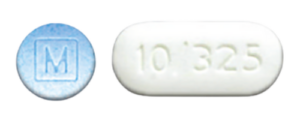
Counterfeit pharmaceutical tablets containing fentanyl kill thousands of people every year, and they can look exactly like the real ones. There is no way to know whether illicitly-purchased pharmaceuticals contain fentanyl without testing them first.
1. Crush the entire tablet into a fine powder.
2. Pour the powder into a small cup.
3. Add approximately four tablespoons (a quarter cup) of water.
4. Stir the mixture. Binder may not completely dissolve. That’s ok.
PROCEED TO STEP 2.
1. Use the same steps above for testing pharmaceutical pills.
PROCEED TO STEP 2.
1. Cut a small corner off the blotter.
2. Soak it in a teaspoon of water for 10 minutes.
PROCEED TO STEP 2.
If you inject drugs, you should try to test every time you inject. The easiest method is to test the residue from your spoon or cooker.
1. After preparing your shot, set the needle aside and wait to inject.
2. Add about 1 ml (1/5th of a teaspoon, or 1 cc) of clean water into the spoon or cooker.
PROCEED TO STEP 2.
STEP 2: Using the strips
After you have diluted your drug using our instructions above, it’s time to use the strips.
1. Hold the yellow end of the test strip and insert the other end into the liquid.
2. Allow the liquid to travel up the strip into the test area for a full 15 seconds.
3. Remove the strip and set it down on a flat surface. Wait about three minutes.
STEP 3: Interpreting the results
One red line on top (closer to the yellow end) after waiting three minutes is a POSITIVE result for the presence of fentanyl. Two red lines is a NEGATIVE result.
- The lower red line may be significantly lighter than the upper red line. If you can see it at all after waiting three minutes, no matter how faint, it is still a negative result.
- No red lines (or one red line on the bottom, closer to the dotted end) means the test is invalid. Usually this happens because the liquid did not travel far enough up the test strip.
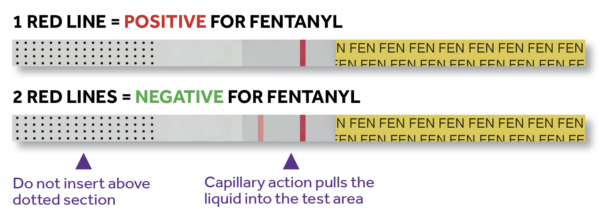
Fentanyl strip testing does NOT destroy your drugs.
You can get your powder back by evaporating away the water. There are many ways to do this, but one of the most popular is pouring the water into a flat-bottomed glass or ceramic dish (like a Pyrex pie dish) and heating it. Other methods involve double boilers, air evaporation (for small quantities), or even blow driers. The most popular method is using an oven.
- Put the pan in the oven on the lowest heat setting, no higher than 225 degrees F.
- Keep the oven door cracked and keep a close eye on the pan. This process can take minutes to hours depending on how much water you’re evaporating.
- When all the water has evaporated, a film/residue will appear on the bottom of the pan. Take the pan out and let it cool.
- This residue usually looks a bit like a thin layer of ice or splotchy crystalline patterns.
- Scrape up the residue using a straight razor or other sharp tool.
- If it’s not fully dry, your powder might be a little tacky or goopy.
Don’t leave your drugs in the oven for too long after they’re dry. They won’t burn right away, but they will eventually. If your drugs weren’t brown to begin with, a tan or brown tint might mean that you’ve burned them.
Except for suicides, overdose deaths are always accidental. The word “overdose” has sometimes carried a moral judgment that the individual was “pushing their limits” in order to get as high as possible, as if it were their own fault.
This is not true. “Overdose” simply means taking too much of a drug, and it is always accidental. Even daily opioid users who know that fentanyl is in their product have no way of knowing the amount.
Instead of blaming others, let’s work together to end accidental overdoses.
DanceSafe fentanyl test strips are the most accurate strips on the market for drug checking and harm reduction purposes. They are available on our website for both retail and wholesale purchases. (Wholesale customers need to register first.)
-
 Add to cartQuick View
Add to cartQuick View -
Popular
 Add to cartQuick View
Add to cartQuick View -
 Add to cartQuick View
Add to cartQuick View -
 Add to cartQuick View
Add to cartQuick View
There are many brands of fentanyl test strips sold on the market today, including on Amazon. All of them were designed only to detect fentanyl in urine. The manufacturers have never tested them to see whether they work for drug checking purposes, which requires specific dilutions and different methods of use. False positives and false negatives are very likely if you use fentanyl test strips that have not been properly assessed.
Only two strips on the market today have been laboratory assessed to work at all for drug checking, including our new, improved DanceSafe strips, manufactured by WHPM.
The best way to know whether you have our new strips is to look at the color of the strip itself:

DanceSafe is proud to introduce a new and improved fentanyl test strip to the harm reduction community. These new strips, manufactured by the US-based company WHPM, utilize a superior antibody with higher specificity to fentanyl and its analogs. This means that unlike other brands of test strips, our new strips do not produce false positives with methamphetamine, MDMA, cocaine, or methadone, when used according to the instructions.
We have verified this through field testing, a commissioned study at Kara Lynch’s lab at the University of California San Francisco (UCSF), and a research collaboration with Marya Lieberman’s lab at the University of Notre Dame (ND).
Our UCSF study also determined that these new strips are dramatically more sensitive than other strips currently on the market.
We have contracted with WHPM to be the exclusive supplier of these new, improved strips for drug checking purposes, and as a 501(c)(3) nonprofit we are committed to offering the lowest possible prices to the harm reduction community. Nonprofits and social service agencies can purchase them right now for bulk pricing as low as $0.45 per strip.
Note: Institutions wanting to receive wholesale pricing need to register first.
Because there are no government agencies regulating fentanyl test strips for harm reduction purposes, we are currently the primary organization performing this function. Without regulations, many manufacturers do not utilize proper quality control standards needed for drug checking. Distributors, as well, often provide no harm reduction instructions with their strips, or they disregard the need for proper dilutions in order to avoid false positives and false negatives. For some, this could be because they do not understand the important differences between urine testing and drug checking. Others may be solely motivated by selling as many strips as possible.
For-profit distributors also typically refuse to disclose the manufacturer of their strips—or pretend that they, themselves, are the manufacturer—in order to prevent new distributors from entering the market and lowering prices. Since every strip works differently, knowing who manufactures a particular strip, as well as the antibody used in the strip, is essential. (Most fentanyl test strips on the market have never been laboratory assessed for harm reduction use, and some do not work at all.)
Manufacturing, assessment, and use standards for fentanyl test strips need to be far higher for drug checking than they currently are for urine testing, because lives are at stake. Our goal is to bring honesty and transparency to the fentanyl test strip industry, to improve the regulatory standards in manufacturing and distribution throughout the supply chain, and to provide the harm reduction community with more reliable and more affordable fentanyl test strips.
For more in-depth information about the science behind fentanyl test strips, how they’re manufactured, the lab studies we are undertaking to assess various brands of strips, and how the immunoassay test strip industry currently operates, please read our introductory brochure.


